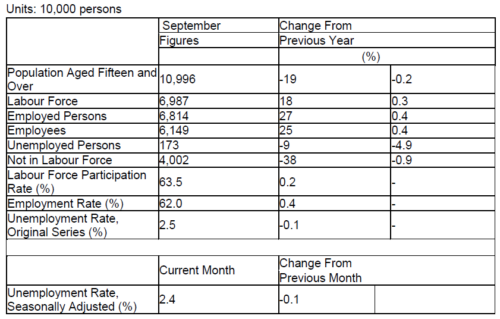Economic and Labour Situation in Japan, November 2024
Rengo to Seek Pay Hike of at Least 5% Next Year
For the 2025 spring wage negotiations, Rengo (the Japanese Trade Union Confederation) is aiming for a wage hike of “over 5%,” the same goal as this year, with a base pay increase of more than 3% in addition to a 2% periodic pay raise, while setting a higher target for small and medium-sized companies to help bridge the salary gap between firms of different size. Rengo is expected to demand a 6% increase for smaller companies, as they tend to see more modest wage hikes due to difficulties in passing on additional costs to their prices. Rengo confirmed its targets on October 18 at an executive meeting and will formally decide on its demands next month.
Labour Force Survey Monthly Results*1
The number of employed women increased, while the number of employed men decreased, in September.
(1) Employment
The number of employed persons in September 2024 was 68.14 million, an increase of 270,000 over the same month the previous year. By gender, this included 37.06 million men, down 160,000, and 31.08 million women, up 430,000 over the previous year.
(2) Unemployment
The number of unemployed persons in September 2024 was 1.73 million, a decrease of 90,000 from the same month in the previous year.
The seasonally adjusted unemployment rate in September was 2.4%, down 0.1 points from the previous month. The unemployment rate for men was 2.7%, up 0.2 points over the previous month, and for women 2.1%, down 0.3 points from the previous month.

(3) Job Availability
Japan’s job availability in September stood at 1.24, up 0.01 points over the previous month. This ratio means there were 124 job openings for every 100 job seekers.
The ratio of regular employee job offers to applicants was 1.01, unchanged from the previous month.
The ratio of new job offers to applicants, a leading indicator for the labour market, was 2.22, down 0.10 points from the previous month. The number of new job offers decreased 5.9%. By industry, information and communications increased 8.9%, while living-related and personal services and amusement services and manufacturing dropped 13.3% and 9.1%, respectively.
Industrial Production*2
Industrial output in September increased 1.4% over the previous month as production of automobiles rebounded following disruption of factory operations due to a powerful typhoon.
Production, shipment, and inventories all increased, while inventory ratio decreased. The industries that mainly contributed to this increase were as follows: (1) motor vehicles; (2) inorganic and organic chemicals; (3) electrical machinery, and information and communication electronics equipment, in that order.
According to the Survey of Production Forecasts in Manufacturing, production was expected to increase 8.3% in October and decrease 3.7% in November.

Family Income and Expenditure Survey *3
(1) Expenditure of Households of Two Persons or More
Average monthly consumption expenditure of households of two or more persons in September was 287,963 yen, up 1.8% in nominal terms but down 1.1% in real terms from the previous year, falling for the second straight month, hit by reduced auto purchases and consumers cutting outlays on food amid higher prices.
(2) Income and Expenditures for Workers’ Households
Average monthly income per household stood at 493,942 yen, up 1.3% in nominal terms and down 1.6% in real terms from the previous year: the first drop in five months. The average level of consumption expenditure was 308,417 yen per month, down 1.1% in nominal terms and down 3.9% in real terms year-on-year.
Consumer Prices *4
The consumer price index (CPI) in September was 108.9 (2020 = 100), up 2.5% over the previous year and down 0.3% from the previous month. Core inflation (CPI less food and energy) was up 2.1% over the previous year and up 0.2% over the previous month.
Prices for rice, Japan’s staple food, soared 46.3% over the previous year, the highest increase in nearly 49 years, due to short supply following last year’s hot summer and higher demand from restaurants. Electricity costs and city gas prices rose 15.2% and 7.7% respectively, despite temporary resumption of government subsidies.

<Y.A>
- Source: Labour Force Survey Monthly Results (Statistics Bureau of Japan)
https://www.stat.go.jp/english/data/roudou/results/month/index.html - Source: Indices of Industrial Production (Ministry of Economy, Trade and Industry)
https://www.meti.go.jp/english/statistics/tyo/iip/index.html - Source: Summary of the Latest Month on Family Income and Expenditure Survey (Statistics Bureau of Japan)
https://www.stat.go.jp/english/data/kakei/156.html - Source: Consumer Price Index (Statistics Bureau of Japan)
https://www.stat.go.jp/english/data/cpi/1581-z.html
